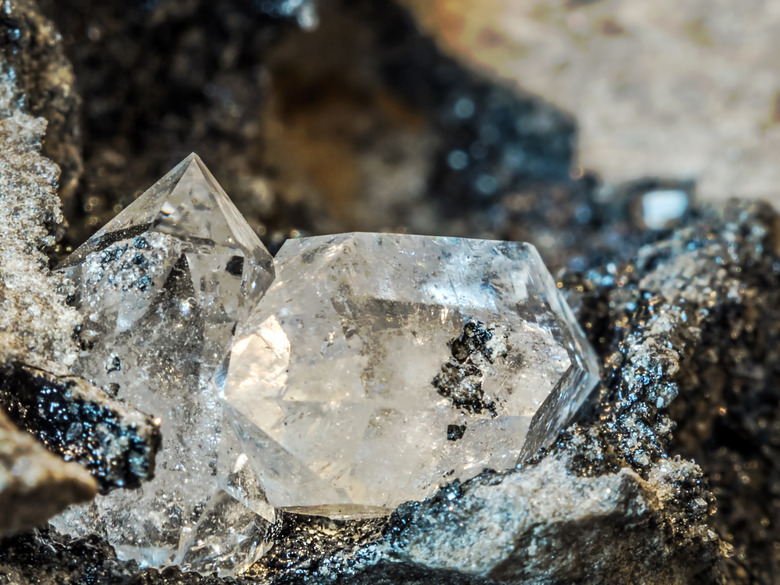How To Identify An Uncut Rough Diamond
Diamonds are beautiful, sparkling gemstones that have come to represent permanence in a relationship. The flash and refraction of light in a cut diamond distinguishes diamonds from almost any other gemstone, but an uncut rough diamond doesn't yet have the jeweler's carefully designed angles to capture and amplify light. Identifying a diamond in the rough requires a more scientific approach that uses a combination of positive tests to identify an uncut rough diamond accurately.
TL;DR (Too Long; Didn't Read)
Uncut rough diamonds resemble water-worn quartz pebbles but can be distinguished based on location and characteristics like crystal form, specific gravity, hardness and other unique features. Diamonds in place have mostly been found in kimberlite pipes in continental cratons. Diamonds form isometric crystals, have a specific gravity of 3.1–3.5, rank 10 on the Mohs Hardness Scale, stick to a grease table, and, in some cases, fluoresce under shortwave ultraviolet light. Correctly identifying an uncut rough diamond uses a combination of these characteristics.
Location, Location, Location
Location, Location, Location
Like many other minerals, diamonds occur in relation to specific geologic features. Most diamonds occur in proximity to kimberlite pipes. Specifically, the kimberlite pipes that most likely to contain diamonds occur in ancient cratons, the oldest and most geologically stable portions of continents. While not all kimberlite pipes contain diamonds, most diamonds occur in association with kimberlite pipes. Kimberlite is an ultrabasic igneous rock that contains at least 35 percent olivine and does not contain any quartz or feldspar.
Diamonds in unweathered kimberlite, termed blue ground, must be extracted by crushing the rock and separating the diamonds. Diamonds in weathered kimberlite, called yellow ground, may be separated by panning or sluice box methods similar to gold mining. Kimberlite erodes relatively quickly from blue ground to yellow ground. Many diamonds have been found in deposits far removed from their kimberlite sources, but the source of the deposits can be backtracked to kimberlite pipes.
The exceptions to this kimberlite association occur where deep crust tectonic motion generates the heat and pressure required to form carbon into diamonds. Microdiamonds in the Japanese island arc and macro diamonds in the Superior geologic province of Canada are associated with lamprophyre dikes. Lamproite, another igneous intrusive rock, contains the diamonds found in the Australian Argyle and Ellendale mines. Microdiamonds have been found in high-pressure metamorphic rocks in China, Europe, Russia and Indonesia. Tiny diamonds have also been found in a few meteorites. In all of these rocks, however, high pressure, high temperatures and a source of carbon were necessary for diamonds to develop.
Crystal Form
Crystal Form
Diamonds belong to the isometric crystal system, most often forming octahedral crystals. "Iso" means same and "metric" means measure, so diamond crystals usually measure approximately the same in all directions around their center. Quartz, most likely to be confused with rough diamonds, forms hexagonal crystals, usually terminating on one end. Herkimer diamonds terminate on both ends, but the hexagonal crystals identify them as quartz crystals.
Specific Gravity
Specific Gravity
Diamonds have a specific gravity of 3.1–3.5. Quartz has a specific gravity of 2.6–2.7. In placer deposits, tumbled quartz pebbles and diamonds can appear similar. The difference in specific gravity, however, allows panning or sluice methods to separate the two minerals. Specific gravity, which is similar to density, lets the lighter quartz travel farther down the sluice or, in smaller particles, wash out of a pan sooner than the denser diamonds. Shaker tables can also be used. When a shaker table is set properly, quartz settles across the center of the table, and the heavier diamonds travel up the table.
Hardness Test
Hardness Test
Diamonds rank as the hardest naturally occurring mineral. The Mohs Hardness Scale ranks minerals from softest to hardest, with talc, the softest mineral, ranked as 1, and diamond as the hardest ranked at 10. All minerals are ranked by this scale. Diamonds can scratch every other mineral, but only diamonds can scratch diamonds. Quartz, the most likely mineral to be mistaken for diamonds in uncut rough form, ranks 7 on the Mohs Hardness Scale. Hardness test kits can be purchased, but they only test through Mohs Hardness 9, which is corundum. Since corundum scratches itself and everything softer, any mineral that corundum won't scratch is diamond. Conversely, any mineral that corundum scratches isn't a diamond. Difficulties with the hardness test include damage to the specimen and the necessity of testing a fresh, unweathered surface. A lower hardness registers if the tested surface is weathered, but diamonds are resistant to weathering.
Additional Tests
Additional Tests
Diamonds don't like water, so miners sometimes use grease to separate diamonds from other rocks and minerals. They pour a slurry of material to be sorted across a greased table. The diamonds stick in the grease, while the rest of the material is carried across the table. Also, about 30 percent of diamonds fluoresce under shortwave ultraviolet light, usually showing up as light blue but also possibly glowing white, yellow, orange or red. Since checking for cleavage, which is fracturing along planes parallel to the crystal faces, requires intentionally breaking the potential diamond, this test should be avoided.
Cite This Article
MLA
Blaettler, Karen G. "How To Identify An Uncut Rough Diamond" sciencing.com, https://www.sciencing.com/identify-uncut-rough-diamond-7627586/. 30 April 2018.
APA
Blaettler, Karen G. (2018, April 30). How To Identify An Uncut Rough Diamond. sciencing.com. Retrieved from https://www.sciencing.com/identify-uncut-rough-diamond-7627586/
Chicago
Blaettler, Karen G. How To Identify An Uncut Rough Diamond last modified August 30, 2022. https://www.sciencing.com/identify-uncut-rough-diamond-7627586/
